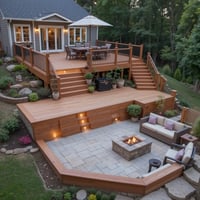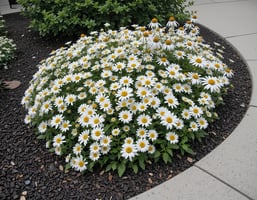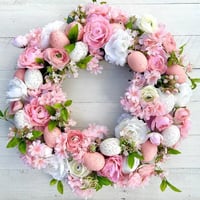Your garden deserves more than just grass and flower beds. It needs a centerpiece that brings...
Transform Your Front Yard: 20 Modern Landscaping Ideas That Actually Work
Your front yard is basically your home's first impression – and let's be honest, nobody wants their house to look like it's stuck in 1995. I've spent the last decade transforming countless front yards from boring grass patches into stunning modern masterpieces, and I'm here to share the secrets that actually work.p
This post contains affiliate links which means I may receive a small commission at no extra cost to you!
Whether you're dealing with a tiny urban space or a sprawling suburban lawn, modern landscaping isn't about following rigid rules. It's about creating clean lines, choosing plants that won't drive you crazy with maintenance, and designing spaces that look effortlessly cool. Ready to make your neighbors seriously jealous?
20. Start with Statement Lighting

Modern landscape lighting transforms your front yard into a nighttime showstopper. I always tell my clients to think beyond those tacky solar stake lights from the hardware store. LED strip lighting under raised planters creates this amazing floating effect that looks like something from a luxury hotel.
Path lighting with sleek geometric fixtures guides visitors while adding architectural interest. You can install low-voltage systems yourself, which saves money and gives you complete control over the design. The key is layering different light sources – uplighting for trees, downlighting for walkways, and accent lighting for focal points.
19. Create Geometric Planting Beds

Forget those curvy, kidney-shaped flower beds from the '80s. Modern landscaping embraces clean geometric shapes that complement contemporary architecture. I love using rectangular or square planting beds with sharp edges – they look intentional and sophisticated.
Raised planters work especially well because they add vertical interest and make maintenance easier. You can build them from concrete, steel, or even composite materials that won't rot. The contrast between structured hardscaping and organic plants creates visual tension that's absolutely stunning.
18. Install a Living Wall or Vertical Garden

Vertical gardens are Instagram gold, and they solve the problem of limited space. I've installed these in tiny front yards where traditional landscaping just wouldn't work. You can go full high-tech with irrigation systems, or keep it simple with modular planting systems.
Succulents work amazingly well for vertical installations because they're drought-tolerant and create interesting textures. The maintenance is way easier than you'd think – most systems have built-in watering, so you're not climbing ladders with a watering can every day.
17. Design with Drought-Tolerant Plants

Water-wise landscaping isn't just trendy – it's smart. I've watched too many homeowners struggle with thirsty lawns and high water bills. Modern xerophytic gardens use plants that thrive with minimal water while looking absolutely gorgeous.
Agaves, ornamental grasses, and architectural succulents create stunning focal points. These plants actually look better when you ignore them – overwatering kills more drought-tolerant plants than neglect ever will. Plus, you'll save money and help the environment.
16. Add Contemporary Water Features

Nothing says "luxury" like the sound of flowing water in your front yard. Modern water features don't have to be those elaborate tiered fountains that scream suburban McMansion. I prefer sleek rectangular reflecting pools or simple bubbling rocks.
Corten steel water walls create amazing rust-colored focal points that age beautifully. The trick is keeping the design simple and letting the materials shine. A single water element often works better than multiple competing features.
15. Use Ornamental Grasses for Movement

Ornamental grasses add life to static landscapes. They move with the wind, change with the seasons, and require almost zero maintenance once established. I use them to soften hard edges and create natural screens.
Feather reed grass stays upright and elegant, while fountain grass adds dramatic texture. Miscanthus varieties provide height and privacy without looking like a formal hedge. The key is choosing grasses that won't spread aggressively and take over your design.
14. Install Hardscape Elements

Hardscaping provides the bones of great landscape design. Concrete, steel, and stone elements create structure that looks good year-round. I love using large format concrete pavers for clean, modern pathways.
Corten steel edging defines planting beds with razor-sharp precision. These materials age gracefully and actually look better over time – unlike wood that rots or plastic that fades and cracks.
13. Create Outdoor Rooms

Your front yard doesn't have to be just decoration – make it functional. Small seating areas or reading nooks turn wasted space into outdoor living rooms. I've created amazing conversation areas using just a few modern planters and a simple bench.
Privacy screens from bamboo or metal panels define these spaces without blocking natural light. The goal is creating intimacy while maintaining openness – you want to feel separated but not isolated from the street.
12. Design with Monochromatic Color Schemes

Color restraint creates sophisticated landscapes. Instead of rainbow flower beds, I use plants with similar color palettes. All-green gardens with different textures and shades look incredibly elegant and timeless.
Silver and blue combinations work beautifully with modern architecture. When you limit your color palette, every plant choice becomes more intentional – and the overall effect is way more polished than busy, multicolored plantings.
11. Incorporate Edible Landscaping

Why not grow food in your front yard? Edible landscaping combines beauty with function, and many edible plants are gorgeous. I've used kale as ornamental plants, and nobody even realizes they're looking at vegetables.
Fruit trees provide seasonal interest and privacy screening. Herb gardens near the front door smell amazing and give you fresh ingredients – plus, they're incredibly low-maintenance once established.
10. Use Large-Scale Planters

Oversized planters create instant drama and sophistication. I love using massive concrete or fiberglass containers as focal points. They work especially well in contemporary designs where scale and proportion matter.
Large planters also solve drainage problems and allow you to control soil conditions perfectly. You can create microclimates for different plants – sun-loving succulents in one area, shade plants in another.
9. Install Permeable Paving

Permeable paving systems handle rainwater while looking incredibly modern. These systems allow water to soak through instead of running off, which prevents erosion and reduces flooding. Plus, they look way cooler than traditional concrete.
Permeable pavers come in amazing contemporary patterns and colors. You get environmental benefits and stunning aesthetics – it's basically a win-win situation that makes you look like a responsible homeowner.
8. Create Seasonal Interest

Great landscapes look good year-round, not just in summer. I choose plants that provide winter structure, spring flowers, summer foliage, and fall color. Evergreen shrubs provide backbone while deciduous plants add seasonal drama.
Ornamental trees with interesting bark or branch patterns look stunning in winter. The goal is creating a landscape that never looks dead or boring – there should always be something interesting happening.
7. Design Sustainable Systems

Sustainable landscaping saves money and helps the environment. I design irrigation systems that use recycled water, choose native plants that don't need fertilizers, and create composting areas that turn waste into garden gold.
Rain gardens capture runoff and filter it naturally through the soil. These systems actually work better than traditional landscaping – and they show you care about more than just curb appeal.
6. Add Architectural Plant Specimens

Statement plants become living sculptures in modern landscapes. Large agaves, architectural palms, or specimen trees create focal points that anchor entire designs. I use these plants like pieces of art.
Japanese maples provide incredible seasonal color and graceful branching patterns. One amazing plant often works better than a dozen mediocre ones – it's about quality over quantity in modern design.
5. Install Modern Fencing and Screens

Contemporary fencing defines spaces without creating barriers. Horizontal slat fencing looks clean and modern while providing privacy. Metal screens with geometric patterns add artistic elements.
Living fences using bamboo or tall grasses create natural privacy that changes with seasons. The key is choosing materials that complement your home's architecture – the fencing should feel integrated, not added as an afterthought.
4. Design Multi-Level Landscapes

Elevation changes create visual interest and solve drainage problems. Terraced gardens work beautifully on sloped lots, while raised planters add height to flat spaces. I use retaining walls as design elements, not just functional necessities.
Different levels allow you to create distinct planting zones and microclimates. Elevation changes make small spaces feel larger – your eye travels through the landscape instead of taking everything in at once.
3. Incorporate Technology Integration

Smart irrigation systems and landscape lighting controlled by apps make maintenance effortless. I install weather sensors that adjust watering schedules automatically. LED lighting systems change colors for holidays or special occasions.
Automated systems take the guesswork out of plant care. Technology should be invisible but incredibly functional – nobody needs to know your landscape is basically running itself.
2. Create Bold Contrasts

Dramatic contrasts make modern landscapes unforgettable. I love pairing soft, flowing grasses with hard geometric hardscaping. Dark mulch makes bright green plants pop, while light-colored stone creates striking backgrounds.
Textural contrasts work amazingly well – smooth concrete against rough natural stone, or fine-textured plants next to bold, architectural specimens. The goal is creating visual tension that keeps people looking.
1. Design for Low Maintenance

The best modern landscapes look amazing while requiring minimal upkeep. I choose plants that thrive in your specific conditions without constant babying. Automated irrigation, slow-release fertilizers, and smart plant choices mean you can actually enjoy your landscape instead of being enslaved by it.
Mulching reduces weeds and conserves water while creating clean, finished looks. A well-designed landscape should get more beautiful over time, not more work. The ultimate goal is creating outdoor spaces that enhance your life without consuming all your free time.
Make It Happen
Modern front yard landscaping isn't about following trends – it's about creating spaces that work for your lifestyle while looking absolutely stunning. The best designs combine functionality with beauty, using plants and materials that age gracefully and require reasonable maintenance.
Start with one or two ideas that excite you most, then build from there. Your front yard should reflect your personality while complementing your home's architecture. Trust me, once you experience the satisfaction of a well-designed landscape, you'll never go back to boring suburban lawns.





